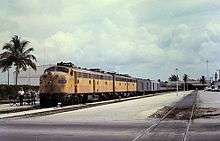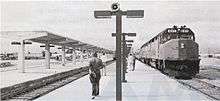Miami station (Amtrak)
Miami station is a train station in Miami-Dade County, Florida, on the border of Miami and Hialeah. It is the southern terminus for Amtrak's Silver Meteor and Silver Star trains. The station opened in 1978 to replace a 48-year-old Seaboard Air Line Railroad station. It is several blocks away from the Tri-Rail and Metrorail Transfer Station, but there is no direct connection between the two. The station was scheduled to be replaced by Miami Intermodal Center in 2016, but this was later cancelled indefinitely.
Miami, FL | ||||||||||||||||||||||||||||||
|---|---|---|---|---|---|---|---|---|---|---|---|---|---|---|---|---|---|---|---|---|---|---|---|---|---|---|---|---|---|---|
%2C_October_2017.jpg) Miami station in October 2017 | ||||||||||||||||||||||||||||||
| Location | 8303 NW 37th Avenue Miami, Florida | |||||||||||||||||||||||||||||
| Coordinates | 25°50′59″N 80°15′29″W | |||||||||||||||||||||||||||||
| Owned by | Amtrak | |||||||||||||||||||||||||||||
| Platforms | 2 island platforms | |||||||||||||||||||||||||||||
| Tracks | 3 | |||||||||||||||||||||||||||||
| Connections | ||||||||||||||||||||||||||||||
| Construction | ||||||||||||||||||||||||||||||
| Parking | Yes | |||||||||||||||||||||||||||||
| Disabled access | Yes | |||||||||||||||||||||||||||||
| Other information | ||||||||||||||||||||||||||||||
| Station code | MIA | |||||||||||||||||||||||||||||
| History | ||||||||||||||||||||||||||||||
| Opened | June 20, 1978 | |||||||||||||||||||||||||||||
| Traffic | ||||||||||||||||||||||||||||||
| Passengers (2017) | 66,110[1] | |||||||||||||||||||||||||||||
| Services | ||||||||||||||||||||||||||||||
| ||||||||||||||||||||||||||||||
| ||||||||||||||||||||||||||||||
History


When Amtrak took over intercity passenger service in May 1971, it continued to use the former Seaboard Air Line Railroad (SAL) depot at 2210 NW 7th Avenue in Allapattah, two miles north of downtown. The SAL station, built in 1930, soon began to show its age. On May 13, 1977, Amtrak began construction of a new station near the SAL's Hialeah Yards.[2]
Opened on June 20, 1978, the building is one of many built under Amtrak's Standard Stations Program, an attempt to create a unified brand and identity for the company's passenger facilities in its early years. It is considered a Type 300A station, meaning it was designed to accommodate at least 300 passengers at the busiest hour of the day. It is nearly identical to the now closed Midway station in Saint Paul, Minnesota, which was also built in 1978.[3]
The building measures 85 feet (26 m) by 175 feet (53 m) with 20,000 square feet (1,900 m2) of floor space, with a large waiting room and other passenger facilities on the ground floor. A mezzanine houses a lounge and Amtrak regional offices. The $5.7 million station construction project ($22.3 million adjusted for inflation) included the fully handicapped accessible station, a 269-car parking lot, and two 2,000 foot (610 m)-long platforms to handle Amtrak's lengthy Florida trains.[2] A loop track runs around the station complex, allowing trains to be turned around for their northbound trips. The last trains arrived at the ex-SAL station on June 19, 1978; the northbound Silver Meteor departed from the new station on June 20 shortly before the ribbon-cutting ceremony.[2][4]
In the early 1990s, the Florida Department of Transportation began planning an intermodal station to link Tri-Rail, Amtrak, and Metrorail to the Miami International Airport. These plans were completed as the Miami Intermodal Center, located 4 miles (6.4 km) south of the current station and an equal distance west of downtown. Metrorail opened to the station in 2012, Tri-Rail commuter trains began serving the new platforms in April 2015, and Amtrak was originally expected to serve this station in 2016, but an error during design resulted in the constructed platforms too short to accommodate the longer trains Amtrak uses during the winter. The original design would have resulted in grade crossings being blocked by the last cars of these longer trains.[5][6] After changes to traffic patterns around the station, Amtrak was initially expected to move to Miami Airport Station in late 2018.[7][8] By late 2018 the move had been cancelled indefinitely.[9]
Station layout
The station has three tracks with two low-level platforms. The station building is located south of Track 1 and directly adjacent to the eastern platform
| P Platform level |
Track 3 | Silver Service toward New York (Hollywood) → |
| Island platform, doors will open on the left or right | ||
| Track 2 | Silver Service toward New York (Hollywood) → | |
| Island platform, doors will open on the left or right | ||
| Track 1 | Silver Service toward New York (Hollywood) → | |
| Street level | Exit/entrance, station building, parking, buses | |
References
- "Amtrak Fact Sheet, FY2017, State of Florida" (PDF). Amtrak. November 2017.
- "New Miami Station Dedicated, Open House Celebrates Event". Amtrak News. Amtrak. 5 (7): 1–2. July 1978.
- The Amtrak Standard Stations Program Amtrak
- Rochester Gets New Station, Amtrak Week Proclaimed By Mayor Amtrak News August 1, 1978 pages 2/3
- Viglucci, Andres (January 5, 2013). "At new Miami train station, too-short platform to require costly fixes". Miami Herald. Retrieved August 10, 2016.
- Krauth, Dan (February 13, 2015). "Miami Central Station Project Mistake Costing Taxpayers Millions". WTVJ. Retrieved May 18, 2015.
- Alfonso Chardy (January 29, 2017). "The trains are too long, the platform is too short. Bad news for the new station". Miami Herald. Retrieved January 29, 2017.
- "Background". Miami Intermodal Center. Florida Department of Transportation. Retrieved August 6, 2016.
- Entin, Brian; Francois, Tania (November 5, 2018). "Off the Rails: Amtrak station built near MIA with taxpayer dollars goes unused". WSVN. Retrieved November 8, 2018.